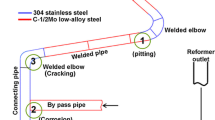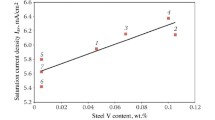Abstract
We investigate the influence of the chemical composition of a weld metal on the long-term crack resistance under static loading in NACE hydrogen-sulfide solution. The effect of C, S, P. Mn, Si, Ni, Cu, V, Zr, Co, B, and Mo on corrosion-mechanical properties of welds is established. Welds containing about 0.11–0.14% C are shown to have the highest crack resistance. The optimum concentrations of manganese (∼0.6%) and silicon (∼0.3%), at which the maximum values ofK 1ssc are obtained, are found. The admissible manganese and silicon contents are 0.39–1.0% and 0.2−0.5%, respectively. The susceptibility to cracking increases with sulfur and phosphorus contents. The highest values ofK 1ssc were obtained at a sulfur content of 0.004 to 0.014% and at a phosphorus content of 0.014 to 0.023%. The adverse influence of these elements in welds is manifested to a lesser extent than in the rolled metal. Alloying with boron is inexpedient and dangerous. Joint alloying with 0.4–0.54% Cu and 0.1–0.3% Ni improves the crack resistance. The influence of molybdenum is analogous (K 1ssc increases by 29–50%). Alloying with 0.5% Co and 0.05% Zr results in the formation of nonequilibrium structures. In this case,K 1ssc is close to those of welds made with carbon steel electrodes. On alloying with 0.2% V, the fine structure forms, andK 1ssc decreases by 20–30%. Alloying with vanadium in these amounts is inadmissible. Preference should be given to complex microalloying.
Similar content being viewed by others
References
A. I. Radkevich, V. P. Koval', E. N. Kalichak, and I. I. Vasilenko, “Corrosion cracking of martensitic stainless steels in hydrogen-sulfide environments,”Korroziya Zashch. Neftegaz. Promyshlennosti, No. 11, 3–5 (1974).
A. I. Radkevich, O. N. Chaplya, and I. I. Vasilenko, “The corrosion-electrochemical behavior of stainless steel in hydrogen-sulfide environments,”Korroziya Zashch. Neftegaz. Promyshlennosti, No. 5, 2–4 (1981).
A. I. Radkevich, M. D. Klapkiv, T. S. Dolotova, and I. I. Vasilenko, “Influence of the composition of an environment containing hydrogen sulfide on the crack growth rate under cyclic loading,”Fiz.-Khim. Mekh. Mater.,20, No. 3, 29–32 (1984).
A. G. Mazel', S. V. Golovin, A. I. Radkevich, et al., “Resistance to hydrogen-sulfide corrosion cracking under cyclic loading of the metal of welds made with the use of modern weld materials,” in:Weld Materials in Construction of Pipelines [in Russian], Izd. VNIIST, Moscow (1987), pp. 104–109.
N. G. Goncharov, A. G. Mazel', A. I. Radkevich, et al., “Effect of chemical composition on the crack resistance of the weld metal under cyclic loading,” in:Problems of Arc and Pressure Methods of Welding of Pipelines [in Russian], Izd. VNIIST, Moscow (1988), pp. 74–79.
I. N. Vornovitskii,Electrodes for Welding of Equipment of Steam Power Plants [in Russian], Énergoatomizdat, Moscow (1983).
G. L. Petrov,Weld Materials [in Russian], Mashinostroenie, Leningrad (1983).
VSN 006-89.Construction of Main and Industrial Pipelines. Welding [in Russian], Minneftegazstroi, Moscow (1990).
NACE Standard TM-01-77.Standard Test Method. Testing of Metals for Resistance to Sulfide Stress Cracking at Ambient Temperatures, NACE, Houston, P.O. Box 218340 (1977).
W. F. Brown and J. E. Srawley,Plane-Strain Fracture Toughness Testing of High-Strength Metallic Materials [Russian translation], Mir, Moscow (1972).
NACE Standard TM0177-90.Standard Test Method. Labratory Testing of Metals for Resistance to Sulfide Stress Cracking in H2SEnvironments, NACE, Houston, P.O. Box 218340 (1990).
MSKR-01-85.A Procedure for Testing for Resistance to Hydrogen-Sulfide Corrosion Cracking [in Russian], Izd. GKNT USSR, Moscow (1985).
O. I. Radkevych, O. S. Pyasets'kyi, and R. K. Melekhov, “Serviceability of nickel alloys and certain steels in hydrogen-sulfide environments,”Fiz-Khim. Mekh. Mater.,13, No. 3, 102–108 (1997).
A. I. Radkevich, N. G. Lebedeva, S. S. Tenenbaum, and I. I. Vasilenko, “Strength of titanium alloys in environments containing hydrogen sulfide,”Fiz.-Khim. Mekh. Mater.,13, No. 5, 49–52 (1977).
M. L. R. Trucbon and J. L. Crolet, “Experimental limits of sour service for tubular steels,” in:Abstracts of the SSC Symposium, Saint-Cloud (1991), p. 21.
Welded pipes for the oil assortment, Nippon Steel Corp., Kokuyo (1991).
T. Kaneko, U. Okada, and A. Ikeda, “Influence of microstructure on the sensitivity to SSC of low-alloy high-strength pipe products for oil-producing countries,” in:Oil Pipes and Pipeline Productions of Sumitomo, Sumitomo Ltd. (1989).
T. Hashimito, Yu. Komidzo, and M. Tsukamoto, “The latest development of pipelines with. a large diameter (brands X-80 and X-100),” in:Oil Pipes and Pipeline Productions of Sumitomo, Sumitomo Ltd. (1989).
I. I. Vasylenko, O. Yu. Shul'te, and O. I. Radkevych, “Influence of chemical composition and steelmaking practice on their sensitivity to hydrogen cracking and hydrogen-sulfide corrosion cracking,”Fiz.-Khim. Mekh. Mater.,26, No. 4 8–22 (1990).
G. M. Pressoure, R. Blondeau, and L. Cadiou, “HSLA steels with improved hydrogen-sulfide cracking resistance,” in:Proceedings of the Conf. of American Society for Metals, Philadelphia (1984), pp. 827–843.
Yu. Ito, M. Nakanishi, and Yu. Kamidzo, “Relation between the carbon equivalent, hardness, and crack susceptibility in microalloyed chromium-manganese structural steel,” in:Oil Pipes and Pipeline Productions of Sumitomo, Sumitomo Ltd. (1989).
M. F. J. Galis, B. J. Orlans, and G. C. Guntz, “Study of metallurgical parameters influencing the behaviour of pipelines in H2S medium,” in:Abstracts of the SSC Symp., Saint-Cloud (1991), p. 17.
D. Bridou, M. Lafrance, and I. Provou, “Development of new marks of steel with improved characteristics for transporting acid gas and oil,” in:Neftegaz-France [in Russian], Moscow (1986).
A. P. Gulyaev,Physical Metallurgy [in Russian], Metallurgiya, Moscow (1977).
V. N. Zikeev,Structural Steels Resistant to Hydrogen-Sulfide Cracking and Brittle Failure [in Russian], Author's Abstract of the Doctor Degree Thesis (Technical Sciences), Moscow (1984).
NACE Standard MR0175-96,Standard Material Requirements. Sulfide Stress Cracking Resistant Metallic Materials for Oilfield Equipment, Houston: P.O. Box 218340 (1996).
Additional information
Karpenko Physicomechanical Institute, Ukrainian Academy of Sciences, L'viv. Translated from Fizyko-Khimichna Mekhanika Materialiv, Vol. 35, No. 1, pp. 95–102, January–February, 1999.
Rights and permissions
About this article
Cite this article
Radkevych, O.I. Effect of the chemical composition of welds of pipelines on their resistance to crack propagation in hydrogen-sulfide environments. Mater Sci 35, 108–117 (1999). https://doi.org/10.1007/BF02355608
Received:
Issue Date:
DOI: https://doi.org/10.1007/BF02355608




